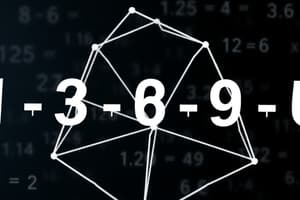Podcast
Questions and Answers
What is the value of $8 + 6$?
What is the value of $8 + 6$?
- $10$
- $12$
- $14$ (correct)
- $16$
The statement $5 imes 0 = 0$ is correct.
The statement $5 imes 0 = 0$ is correct.
True (A)
What is the square root of $64$?
What is the square root of $64$?
8
The ______ of a triangle is calculated using the formula $\frac{1}{2} \times \text{base} \times \text{height}$
The ______ of a triangle is calculated using the formula $\frac{1}{2} \times \text{base} \times \text{height}$
Match the following mathematical terms with their definitions:
Match the following mathematical terms with their definitions:
Flashcards
Mathematics
Mathematics
The branch of science dealing with numbers, shapes, and their relationships. It involves studying patterns, making calculations, and solving problems.
Variable
Variable
A symbol used to represent a specific quantity or value. It can be a number, a letter, or a combination of both.
Equation
Equation
A mathematical statement that shows the equality between two expressions. It has a left side and a right side connected by an equals sign.
Solving an equation
Solving an equation
Signup and view all the flashcards
Graph
Graph
Signup and view all the flashcards
Study Notes
Fundamental Concepts
- Mathematics is a vast field encompassing various branches, each with its own set of concepts and tools.
- Core branches include arithmetic, algebra, geometry, calculus, and statistics.
- Arithmetic deals with basic operations like addition, subtraction, multiplication, and division, typically on numbers.
- Algebra involves the use of variables to represent unknown quantities and solve equations.
- Geometry focuses on shapes, sizes, and spatial relationships, often involving lines, angles, and plane figures.
- Calculus deals with continuous change and motion, encompassing concepts like derivatives and integrals.
- Statistics involves collecting, analyzing, and interpreting data to draw conclusions.
- Many interconnected concepts within each branch, creating a rich and complex field.
Number Systems
- Natural numbers: Positive integers (1, 2, 3, ...).
- Whole numbers: Natural numbers plus zero (0, 1, 2, 3, ...).
- Integers: Whole numbers and their negative counterparts (... -3, -2, -1, 0, 1, 2, 3, ...).
- Rational numbers: Numbers that can be expressed as a fraction p/q, where p and q are integers and q ≠ 0.
- Irrational numbers: Numbers that cannot be expressed as a fraction of two integers. Examples include π (pi) and √2.
- Real numbers: The set of all rational and irrational numbers.
- Complex numbers: Numbers that can be expressed in the form a + bi, where a and b are real numbers and i is the imaginary unit (i² = -1).
Basic Arithmetic
- Operations: Addition, subtraction, multiplication, division, modulo.
- Properties: Commutative, associative, distributive, identity, inverse.
- Order of operations (PEMDAS/BODMAS): Parentheses, exponents, multiplication/division (from left to right), addition/subtraction (from left to right).
- Estimation: Approximating values for calculations.
Algebra
- Expressions: Combinations of variables and constants using mathematical operations.
- Equations: Statements that two expressions are equal.
- Inequalities: Statements that one expression is greater than or less than another.
- Solving equations: Isolating the unknown variable.
- Functions: Relationships between input and output values.
- Graphing equations and functions: Representing relationships visually.
Geometry
- Shapes: Lines, angles, triangles, quadrilaterals, circles, polygons, etc.
- Properties: Attributes of each shape (e.g., angles, lengths, area, volume).
- Transformations: Translations, rotations, reflections, dilations.
- Coordinate geometry: Using coordinate systems to represent shapes and their properties.
- Euclidean geometry: Classical geometry based on axioms and postulates.
- Non-Euclidean geometry: Geometries that differ from Euclidean geometry, such as spherical or hyperbolic.
Calculus
- Derivatives: Rate of change.
- Integrals: Accumulation of quantities.
- Applications: Optimization, motion problems, modeling continuous change, areas, volumes.
Statistics
- Data collection: Gathering information systematically.
- Data representation: Summarizing data using tables, charts, graphs.
- Data analysis: Describing and interpreting data.
- Measures of central tendency: Mean, median, mode.
- Measures of dispersion: Variance, standard deviation.
- Probability: Assessing the likelihood of events.
- Statistical inference: Drawing conclusions about populations based on samples.
- Hypothesis testing: Evaluating if observed data provides enough evidence to support a claim.
Discrete Mathematics
- Discrete structures: Objects that are distinct and separate, like integers, graphs, sets.
- Logic: Formal reasoning, including propositional logic and predicate logic.
- Counting principles: Permutations and combinations.
- Graph theory: Studying relationships between objects.
- Set theory: Dealing with collections of elements.
- Relations: Mapping elements from one set to another.
Applications of Mathematics
- Various fields of study use mathematics to model, solve, and understand complex phenomena.
- Examples include physics, engineering, computer science, economics, and biology.
- Mathematical modeling plays a key role in these applications.
Studying That Suits You
Use AI to generate personalized quizzes and flashcards to suit your learning preferences.
Description
Explore the core branches of mathematics including arithmetic, algebra, geometry, calculus, and statistics. This quiz covers essential concepts and number systems that form the foundation of mathematical study. Test your knowledge on how these branches interconnect to create a rich discipline.




